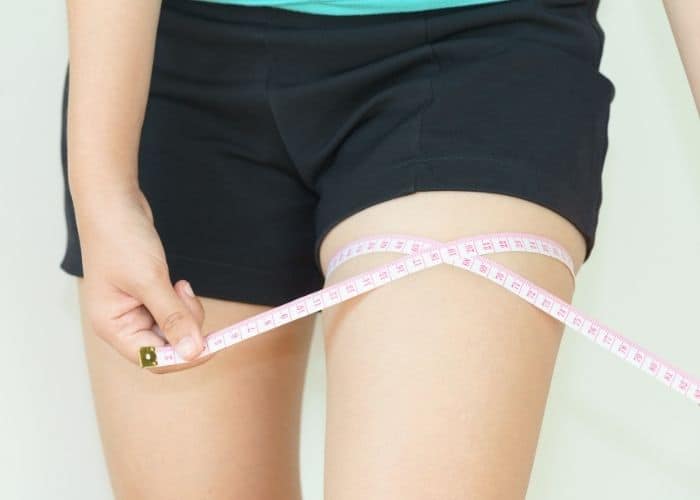
Taking that first step to lose weight can be incredibly challenging. Even more so when you hit obstacle after obstacle in your way of achieving your dream.
Such is the case with your thighs.
Trust me, I hate mine, too.
Why are my thighs big? Your thighs are big when working out because you’re bulking up the muscles in your leg. When you do that, they’ll appear to be bigger, but over time, the fat on top will melt away. You could also have bigger thighs because of genetics.
Is there any hope?
Absolutely!
I’ll help you figure out how to diagnose your thigh situation so you can get on the track to slimming your thighs down and feeling confident about your body.
In this article, I’ll go over:
- 7 reasons why your thighs got bigger overnight
- Fat thighs vs. muscular thighs
- Why your thighs and hips got big
- Average thigh size
- If big thighs are genetic
- Why your thighs might be big but you’re skinny
- How you can reduce your big thighs
- 5 reasons why your thighs aren’t getting smaller
Let’s get started!
Table of Contents
My Thighs Got Bigger Overnight
It can be very scary to wake up one morning and see that your thighs got bigger overnight with no seemingly understandable explanation.
Why did it happen? Was it something you did?
If your thighs are getting bigger overnight, it could be because of cellulite.
According to research in the International Journal of Cosmetic Science, the presence of cellulite is an aesthetically unacceptable cosmetic problem for most post-adolescent women.
So, what can you do about it?
Here are 7 reasons why your thighs might have gotten bigger overnight:
- Sudden inactivity
- You’ve started on contraception / the pill
- You’re pregnant
- You’ve consumed way too much sugar
- Excessive alcohol consumption
- It’s your period (where water accumulates in tissues)
- Fast weight gain
If none of those apply to you, you may just be second-guessing your figure.
I don’t blame you.
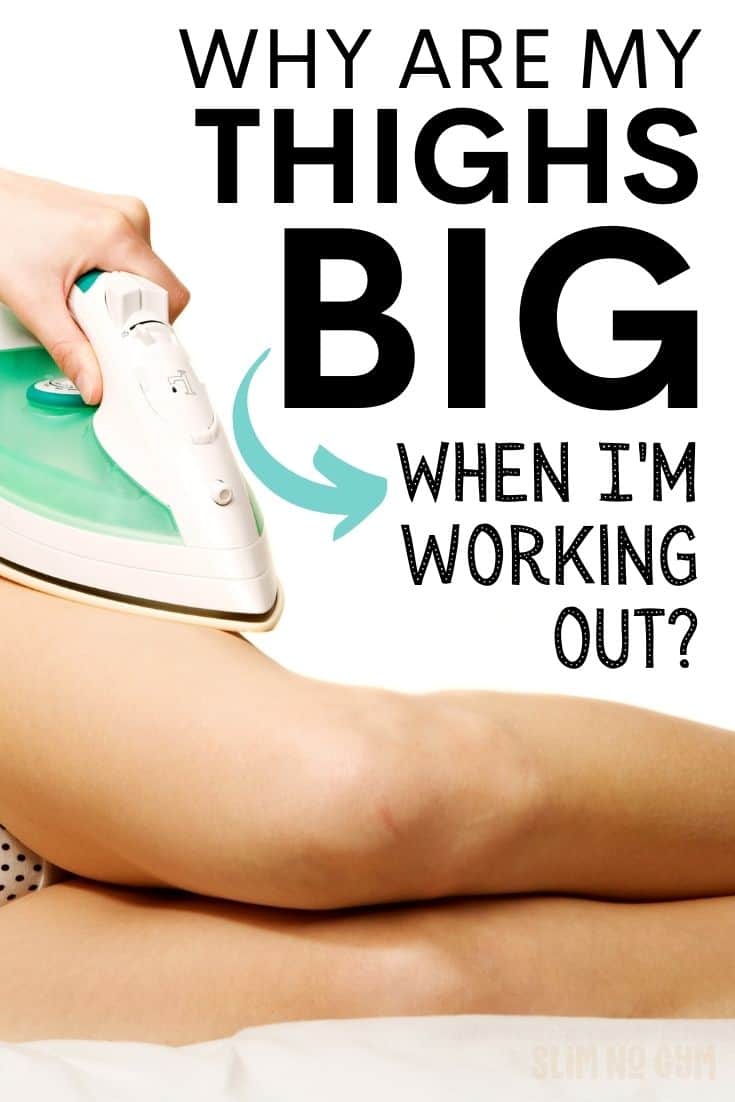
Fat Thighs vs. Muscular Thighs
I wanted to go over this before you see what the average thigh size is.
Why?
It’s important to recognize that your thighs may be large because of excess fat deposits or because you’ve bulked up on muscles.
Here’s an easy picture of your anatomy:
- On top is your skin
- Under your skin is fat
- Under the fat is muscle
When you exercise, the muscles get bigger, but that doesn’t necessarily mean that the thighs (or your fat) are getting smaller.
The various fluctuations in thigh fat and muscle are responsible for the size changes to your thighs. Your thighs won’t start to slim until around 18% body fat.
So, before you measure your thighs and panic, remember that you can work on slimming down your thighs.
You should know whether you have fatty thighs or muscular thighs.
Why Did My Thighs Get So Big? Why Are My Hips and Thighs Getting Bigger?
If you notice that your thighs are getting big, that’s a sign your body is in the middle of a transition.
That’s a good sign when working out!
When you exercise, you’re adding muscles to your legs and thighs. That will increase the overall size of your thighs until you burn the fat that rests above the muscles.
Alternatively, you could simply have big thighs and hips because you’ve added weight and the extra calories are manifesting there.
But, if you’ve taken the right steps to slim your thighs, you shouldn’t be concerned.
Weight-Friendly Tip
When you’ve made the commitment to lose weight and get your body in shape, it won’t happen overnight. It can take months and even years to slim and shape your body to exactly how you’ve envisioned it. Don’t give up because you encounter a small obstacle. Learn from it so you can move forward.Here are some other things you might be wondering when it comes to your thighs:
- What’s considered as big thighs?
- Are big thighs genetic?
- Is it good to have big thighs?
- Why are my thighs big but I’m skinny?
Let’s explore these in a little more depth!
What’s Considered as Big Thighs?
I already mentioned the difference between fatty thighs and muscular thighs, so when you measure your thigh circumference and compare it, don’t be afraid of what you learn.
Here’s the average thigh size and what qualifies as a small and big thigh.
Thigh Size
| Thigh Circumference | What it Means |
|---|---|
| Less than 20 in (51 cm) | Your thighs are skinny |
| 23 in (58 cm) | Your thighs are average |
| 25 in (64 cm) | Your thighs are big |
These metrics were taken from LiveStrong and are used in guidelines for bodybuilding, so they’re going to have more muscle than fat in their thighs.
Unless your thighs are massively sized from bodybuilding, then the numbers are pretty on par. But, your height is another factor to consider.
Are Big Thighs Genetic?
Part of having big thighs is genetic and part of it is down to your lifestyle and diet.
Research published in the Journal of Clinical Endocrinology and Metabolism suggests that belly and thigh fat are genetically destined for their final destination during development. This means that the cells are preprogrammed to serve a specific function.
But, it’s not all bad.
They also said that even though many women hate having large hips and thighs, that pear shape actually reduces their risk of heart disease and diabetes.
The problem, they continue on to say, isn’t the fat, but rather, it’s location. It’s better to have it on the hips and thighs than on the belly.
So, don’t feel bad if you’ve had big thighs your entire life. It’s likely the way you were created.
Is it Good to Have Big Thighs?
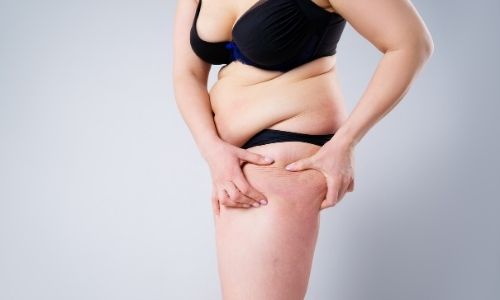
Big thighs aren’t as much of a problem as you may believe.
Harvard University says that fat plastered around the body’s internal organs (visceral fat) is much more dangerous than the fat layered beneath the skin (subcutaneous fat).
In other words, while big thighs may not look great or up your sense of self-confidence, they’re better for you than belly fat.
If you have belly fat AND thigh fat, then work on getting rid of the belly fat first to avoid diabetes and heart disease.
Here’s a quick helpful formula for the waist-to-hip ratio that’ll help you figure out if you need to be concerned:
- Measure your waist and hips
- Divide your waist measurement by your hip measurement
If your ratio is 0.85 or higher for women and 0.95 or higher for men, then your body fat measurements mean you’re at high risk for adverse health.
If you’re in that range, make sure you keep reading so you can reduce the fat on your body.
Why Are My Thighs Big But I’m Skinny?
It could be just genetics.
But, you could be exercising in the wrong way.
If your thighs are big and you’re skinny overall, then you may not be exercising your upper body as much to keep it in proportion with your lower body. Or, you simply gain more fat on the lower part of your body.
If you have skinny arms, you can fix that.
If your fat isn’t evenly distributed, then you may want to try targeted or isolation exercises to slim down certain parts of your body.
How Can I Reduce My Big Thighs?
Great question!
One of the best ways to reduce your big thighs is through resistance training. If you can commit two days a week to total-body, muscle-burning activities, you can reduce your thigh size. Make sure to include lower-body exercises, too.
Some lower-body exercises include:
- Lunges
- Wall sits
- Inner and outer thigh lifts
- Step-ups
Weight-Friendly Tip
Before you go to town on exercises to slim down your thighs, remember this. Your overall cardiovascular and muscular health is more important than the size of your jeans or how your dress rides your thighs. Focus on strengthening your thighs, not just making them smaller.But, I’m sure you have other questions on how to reduce your thigh size, so I came up with this list:
- Does walking reduce thigh size?
- What foods cause thigh fat?
- Do squats make your thighs bigger?
- How do I stop my legs from getting bigger?
Let’s dive a little deeper!
Does Walking Reduce Thigh Size?

Brisk walking can improve your metabolic rate, but it’s unlikely that walking alone will make your thighs smaller.
If you’re committed to walking to reduce your thigh size, then you need to walk briskly for at least 15 to 20 minutes to trick your body into burning its fat reserves. But, that doesn’t address the muscles in your thighs that you should be bulking up to help destroy the fat.
But, walking does tone your:
- Calves
- Quads
- Hamstrings
- Glutes
But, all this is moot if you don’t walk quickly. And, if you’re going to walk quickly, you might as well make it a light jog.
What Foods Cause Thigh Fat?
Generally speaking, your body has its own unique system for depositing extra calories as fat cells in your body.
There’s little you can do to control where the fat gets added. What you can do is try to consume the right foods so that only healthy fat is added.
In my article on 27 foods that make your butt bigger, I went over the right kinds of foods you should be eating to add the right kind of fat.
Those food groups include:
- Vegetables
- Whole grains
- Nuts and seeds
- Dairy
- Meat
- Vegan
But, generally speaking, your thighs will gain fat because you’ve consumed a caloric surplus.
The only way to avoid that is to count your calories, exercise, and consume a caloric deficit.
Do Squats Make Your Thighs Bigger?

Yes, squats make your thighs bigger.
Squats are more effective at sculpting your thighs when you introduce weights into the process. That’s known as resistance training and it works multiple parts and muscle groups of your body simultaneously.
What you have to remember is that squads add muscle to your thighs, not fat.
So, even though your thighs may be getting bigger, it’s for the right reason.
How Do I Stop My Legs From Getting Bigger?
Low-intensity cardio is a great way to burn fat and slim down your thighs.
Here are a few other things you can try:
- Fasted cardio
- Follow a low-carb diet
But, unfortunately, women tend to put on weight on their hips, thighs, and legs, so you may not be able to stop your legs from getting bigger.
What you can do, however, is ensure that they’re only getting larger because of muscles and not fat.
5 Reasons Why Your Thighs Aren’t Getting Smaller
If you’ve been working hard to slim down your thighs to no success, I’ve been there.
It can be quite challenging!
Here are 5 reasons why you might not be achieving the results you want to be:
- Your diet
- Not enough cardio
- Exercising only part of your leg muscles
- Not using weights
- Unrealistic expectations
Now, you know your body better than anyone else, so it’s up to you to modify your exercise regiment when you realize your body is looking different than what you want it to.
Let’s explore these a little more!
1. Your Diet

If you want to really change your lifestyle and health, the first thing you have to do is change your diet.
It can be small at first to adapt, but you’ll likely need to make major changes. Your choices got you to where you are today.
When considering what to put in your diet, the following are helpful:
- Protein
- Vegetables
- Fruit
- Healthy fats
Protein is incredibly important to add into your diet because it builds muscle while raising your metabolism, causing you to shed fat quicker.
If your grandma doesn’t recognize it as food, then it’s probably not that healthy for you.
2. Not Enough Cardio

If you’re already training your body a few days per week and still not noticing results, then it’s time to change things up.
Add cardio!
Cardio is the gift that keeps on giving because it helps make your body lean.
With cardio, you can easily burn 400 to 700 calories an hour, which should help you tremendously on your way to a caloric deficit.
If you do it on an incline, that’s even better.
Not sure if you can do calisthenics every day? I got you covered.
3. Exercising Only Part of Your Leg Muscles
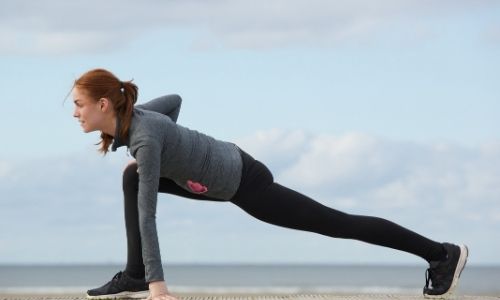
Isolation exercises can be effective if there are specific body parts or muscle groups you want to work out.
But, by doing those, you’re NOT working your whole body.
By not working out all your muscle groups and sticking to exercises like running and cycling only, you’re putting yourself at risk of tightening your hip flexors and causing a knee injury.
That’s certainly not ideal.
Give all the muscle groups in your leg some love.
4. Not Using Weights
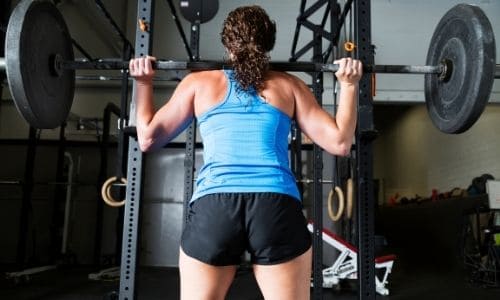
If you’re taking the time to exercise but you’re not using any weights, then you might not be realizing the full potential of those exercises.
The best way to increase your muscle size is to challenge them, which breaks down the muscle fibers and forces the muscle to rebuild itself, but stronger.
Once an exercise no longer feels challenging to you, it’s time to up the weights or resistance.
You can increase the weight by about 2 pounds every time you think you’re ready for a change.
5. Unrealistic Expectations
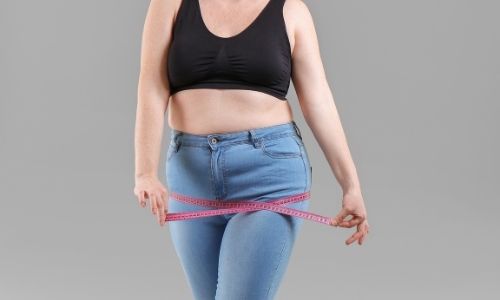
Doing a few hardcore workouts is NOT going to change your overall thigh appearance.
If you can commit to doing strength training on your lower body 3+ times per week, then you should start to see changes in about 4 to 6 weeks.
But, it may take months or even years to get the change you’ve envisioned.
Conclusion
I hope you’re feeling more confident about why your thighs are the shape and thickness they are.
In case you missed my answer on why your thighs are getting bigger even though you’re exercising, here it is again.
Your thighs are big when working out because you’re bulking up the muscles in your leg. When you do that, they’ll appear to be bigger, but over time, the fat on top will melt away. You could also have bigger thighs because of genetics.
I also went over:
- 7 reasons why your thighs got bigger overnight
- Fat thighs vs. muscular thighs
- Why your thighs and hips got big
- Average thigh size
- If big thighs are genetic
- Why your thighs might be big but you’re skinny
- How you can reduce your big thighs
- 5 reasons why your thighs aren’t getting smaller
Do you have any questions about your thighs you didn’t see addressed in this article? Let me know in the comments below.
Keep me posted on how you’re achieving your dream body.
To your weight loss success!

